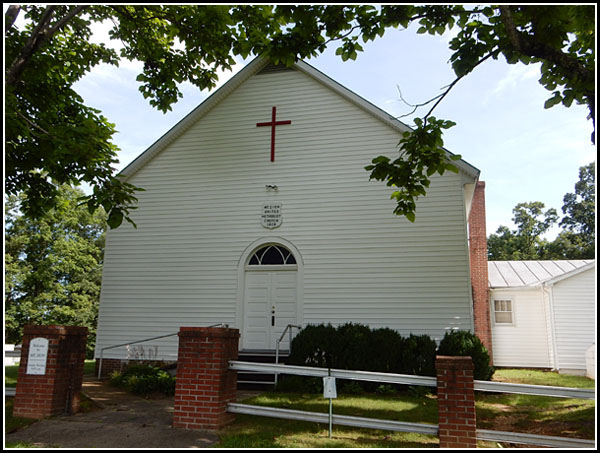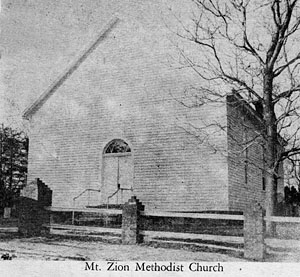

  |
|

|
Name: Mt. Zion Methodist Church, Esmont Date: 2016 Image Number: CG1137cdCG2016 Comments: Mt. Zion Methodist Church in Esmont began as a log meeting house built by the slaves of Benjamin Childress in 1828. When it was finished, Mr. Childress donated the house to the Methodist Conference. Later the congregation erected a brick building but because of a defective foundation, the church became unsafe, and the central part of this white frame church above was erected in 1881. To the left of the church building is the church cemetery begun in 1843 with land donated by Mr. Childress. Directions from Scottsville Museum to Mt. Zion Methodist Church, 2620 Mount Zion Church Road, Esmont: Drive west from the Museum on East Main Street and turn right on Valley Street. Turn left onto Irish Road/VA-6 and drive approximately 5.7 5 miles. Turn left on Porters Road and drive 1.63 miles. Turn right on Mount Zion Church Road and drive to the church at 2620 Mt. Zion Church Road. Mt. Zion Methodist: One of the Oldest Churches in the Area. Early in the history of the settlement of Virginia, we find that whenever a family established a home and it became surrounded with the homes of others, there sprang up in their midst a place of worship. Even before this, when homes were widely scattered, and country churches were few and far between, at the beginning of the 18th century, the Methodist people were visited by the "circuit Rider." Wherever night overtook this minister, the neighbors were called in and a worship service was held. From these beginnings many of the old Methodist churches have risen. And this is true of Mt. Zion Methodist Church near Esmont Around the year 1785, Benjamin Childress bought 2200 acres of land near Scottsville and built his house. The estate was called Seven Oaks, the home of the late Mrs. L. I. Turner. 
In 1828, Mr. Childress had his slaves build a log meeting house for church services on the same site on which stands Mt. Zion Church. When it was finished, Mr. Childress donated the house to the Methodist Conference. The church grew and prospered. Later the congregation erected a brick building but, because of a defective foundation, this church became unsafe, and the present white frame building was put up in 1881 as shown at right. Additional work and various improvements have been put into the church since that time. On 1904 when Rev. C.E. Blankenship was pastor, the first important changes were made. The vestibule was built inside the old plain windows replaced with the present ones, and the arch behind the altar was added. Concrete steps and walk were made during the term of Rev. Joe Patterson. In the last few years, the church has been painted inside and out and the brick underpinning was put between the original old pillars.
At the first homecoming, when Rev. T.E. Johnson was pastor and Rev. L.P. Bland visiting preacher, the contributions were put toward marble markers that are numbered. They were placed at the unmarked graves. Meantime, Mr. Earle, who owned "Canaan Farm" close by, deeded to the church more land for burial purposes. The cemetery was then seeded to grass, and when this failed, W.A. Dawson cut sod from his meadows and set it on the graves, watering it daily. Since then, all offerings on Homecoming Day are for the improvements of the cemetery and the fund for perpetual care. In 1950, there was a committee appointed to look after the cemetery. This includes J.C. Childress, Herman Patterson, and Martin Dawson. A new fence has been built around the grounds, supervised by Mr. Childress. The continual progress of this little country church has been made possible by the unfailing liberality of friends, former members, and those now active in the church. It is a fine example of work and devotion. Copyright © 2018 by Scottsville Museum |
|
|
|
Museum
Archive
Business
Cemeteries
Church
Events
Floods
For Kids
Homes
Portraits
Postcards
School
Transportation
Civil War WWII Esmont Search Policy |
||||
|
Scottsville Museum · 290 Main Street · Scottsville, Virginia 24590 · 434-286-2247 www.avenue.org/smuseum · [email protected] Copyright © 2018 by Scottsville Museum |
||||